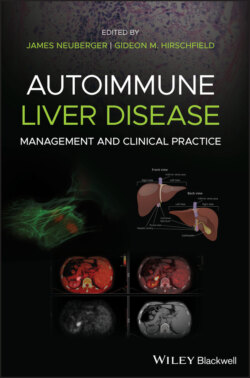Читать книгу Autoimmune Liver Disease - Группа авторов - Страница 37
Hepatocellular Necrosis
ОглавлениеElevation of ALT and AST indicates hepatocellular necrosis. The interpretation of these increases should consider the rate of rise, the severity (peak level), the AST/ALT ratio, and coexisting abnormalities in other LFTs and other investigations. ALT and AST are enzymes that catalyze the transfer of amino groups from alanine or aspartic acid to ketoglutaric acid to form pyruvic acid and oxaloacetic acid, respectively, during gluconeogenesis. ALT is localized primarily in the liver and confined to the cytoplasm, while AST can be released by the liver, myocardium, skeletal muscle, kidney, pancreas, and blood cells, and can be found in the cytoplasm and mitochondria. During hepatocellular injury they are released into the bloodstream. However, their increase is not always pathologic: they can be raised by vigorous physical activity, and rarely an isolated AST can be the result of the binding of the enzyme with an immunoglobulin forming a macro‐enzyme (macro‐AST) complex. The diagnostic specificity of mild‐to‐moderate increases in aminotransferases is poor, with many differential diagnoses being possible, whereas the spectrum of liver conditions indicated by markedly elevated aminotransferase levels (>2000 IU/l) narrows to viral (mostly hepatitis A and hepatitis B virus), ischemic (shock liver), and drugs. Autoimmune hepatitis can sometimes have an acute outset with striking elevation of aminotransferases. Rarely, bile duct stones can manifest as marked rise in aminotransferase, although this is followed by a rapid fall within 48 hours.
The AST/ALT ratio can often provide a clue to the diagnosis. In the majority of cases of hepatitis, the AST/ALT ratio is less or equal to 1. The AST/ALT ratio is typically greater than 2 during alcoholic hepatitis. This occurs because damage is primarily mitochondrial (thus more AST is released systemically) and ALT synthesis is more sensitive than AST to pyridoxal 5‐phosphate deficiency, a common finding in alcoholics, leading to lower serum ALT levels. Supplementation with pyridoxine in patients with alcoholic hepatitis results in a rise in the level of ALT. An AST/ALT ratio greater than 1 in patients without a history of alcoholism is suggestive of advanced fibrosis or cirrhosis. An AST/ALT ratio greater than 4 is observed in patients with fulminant Wilson disease.
